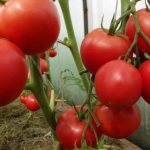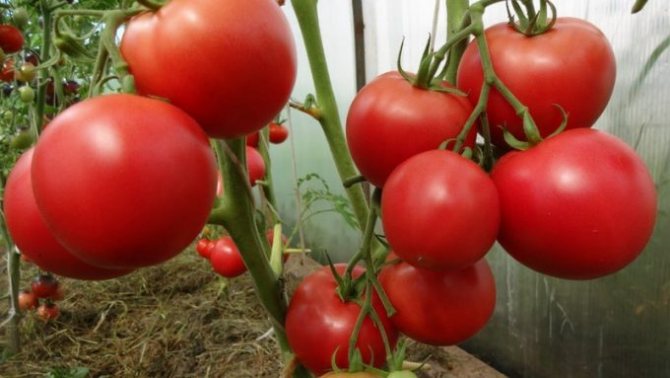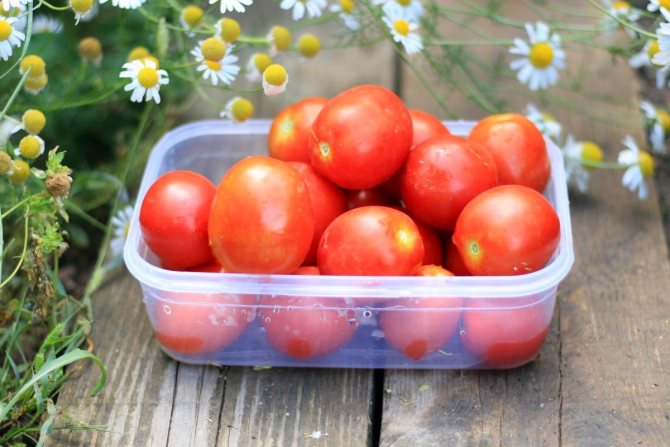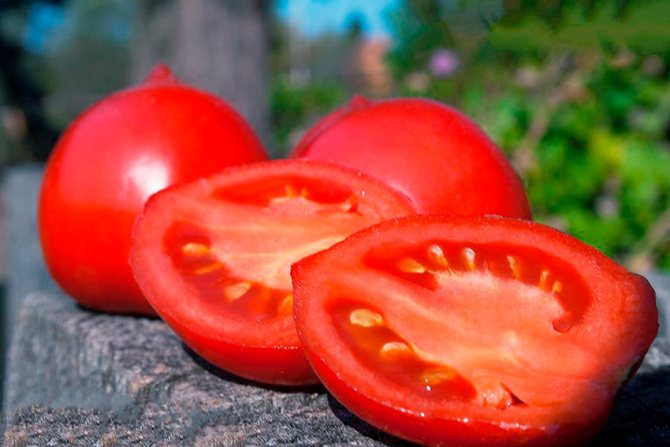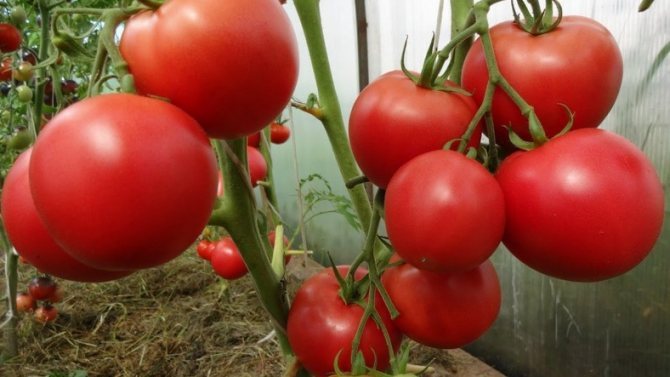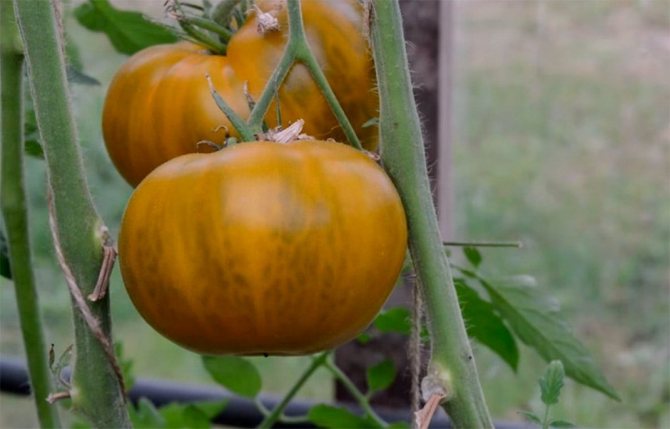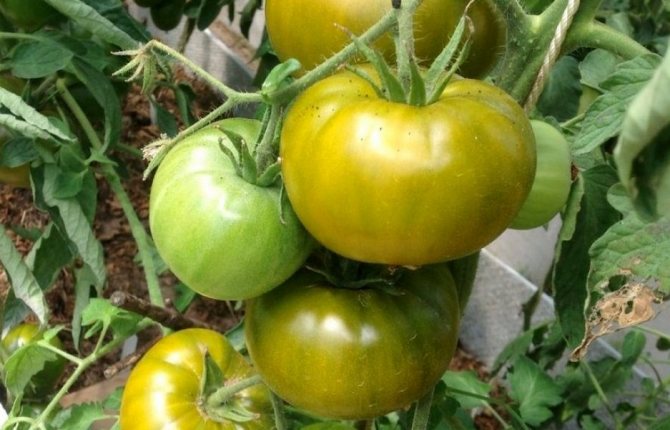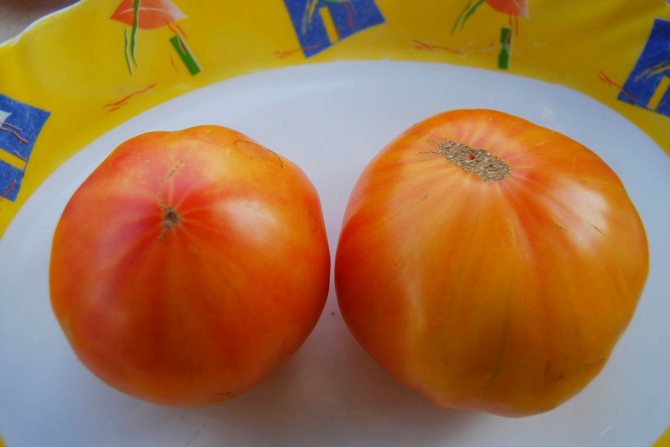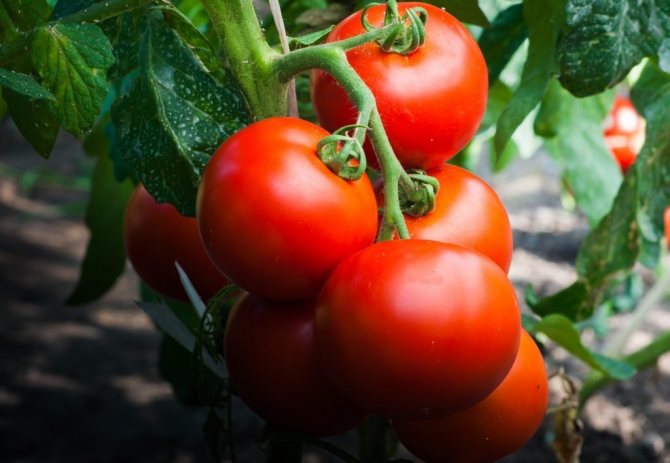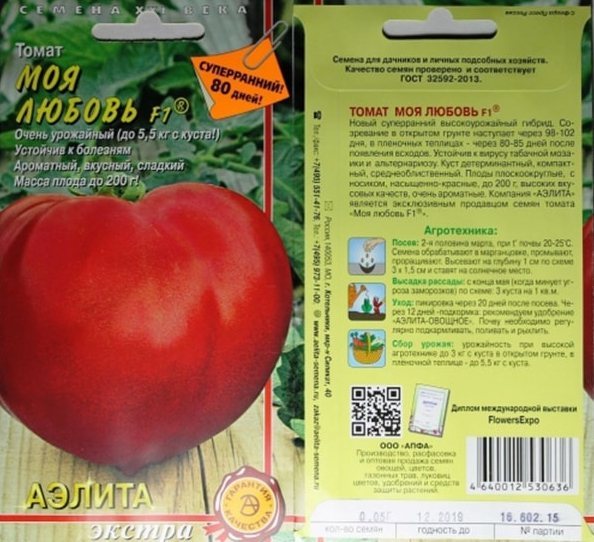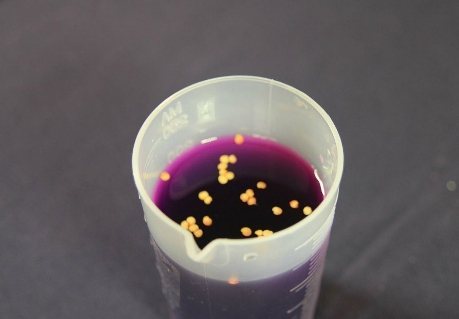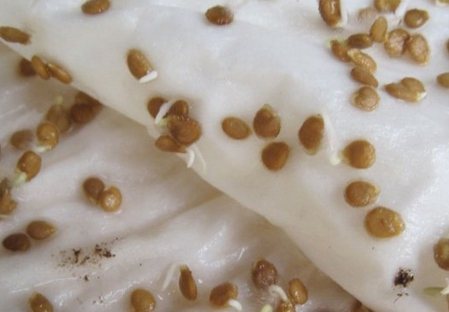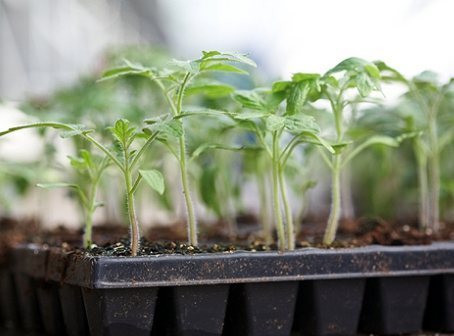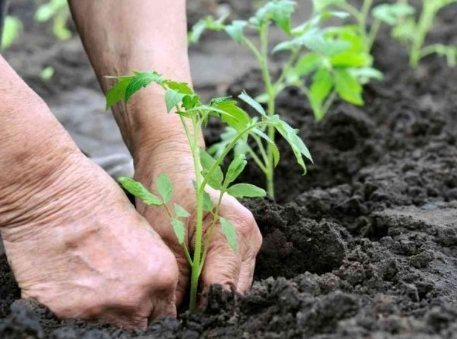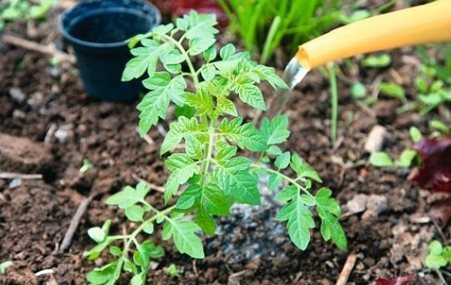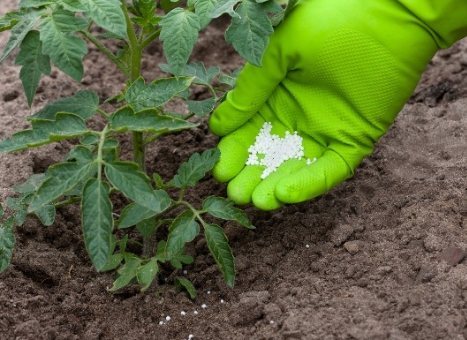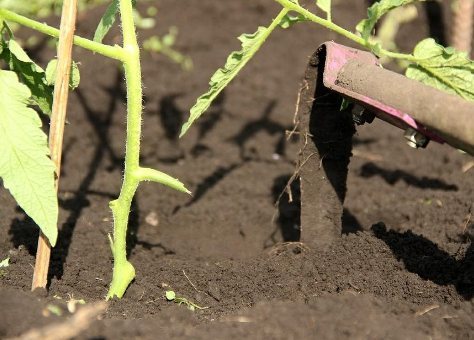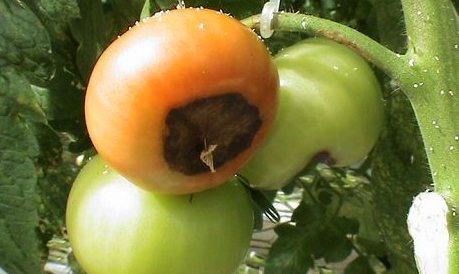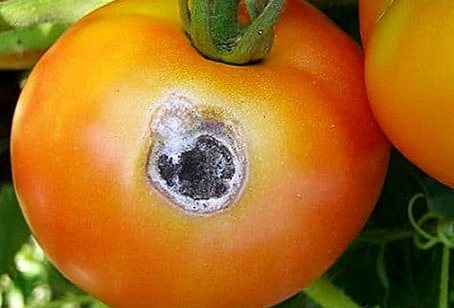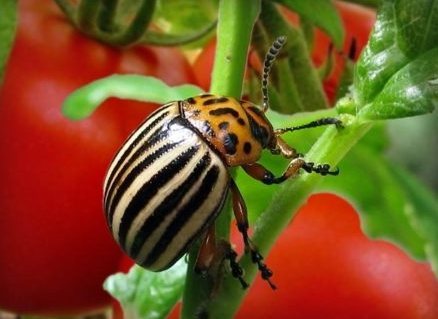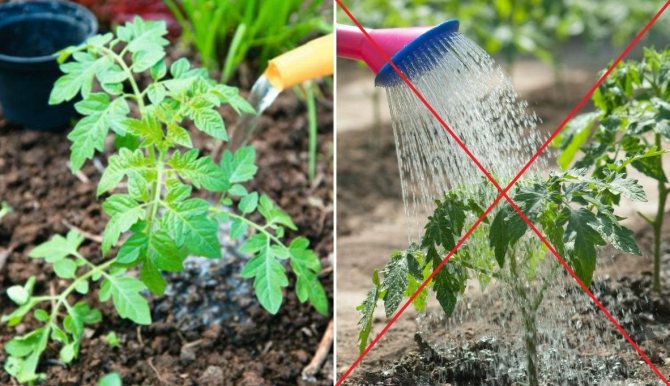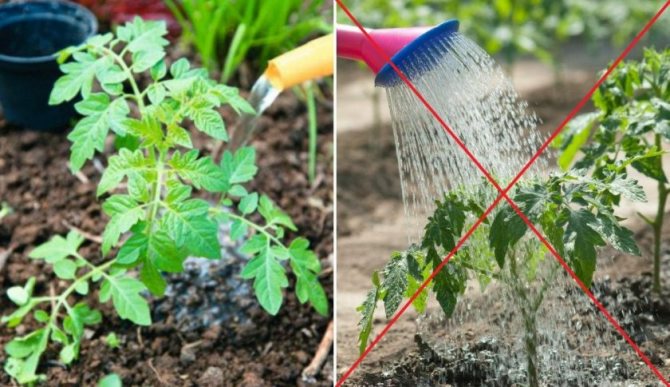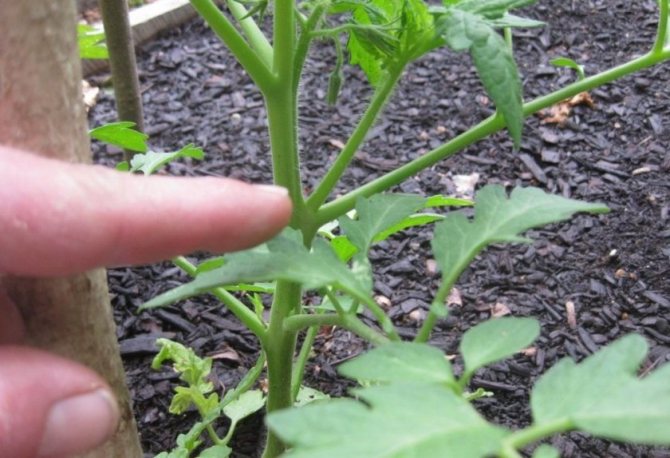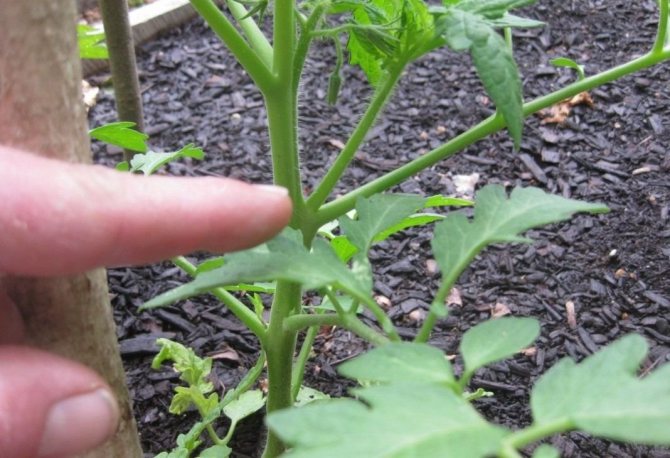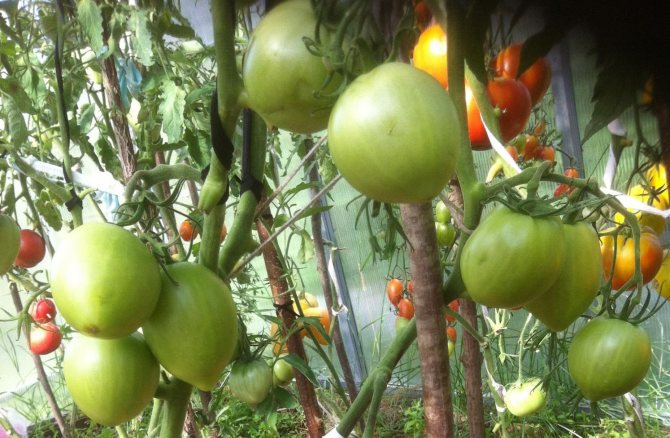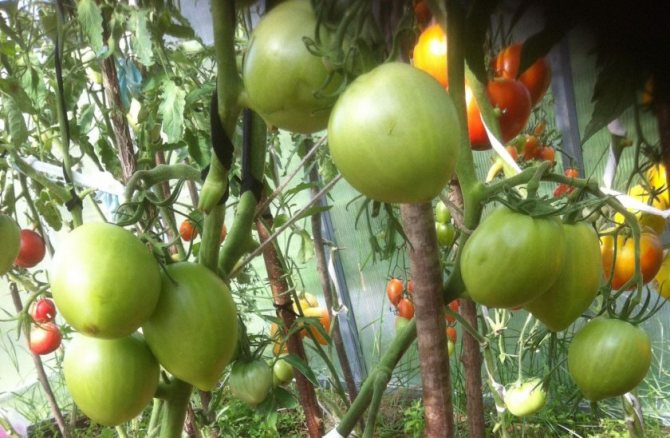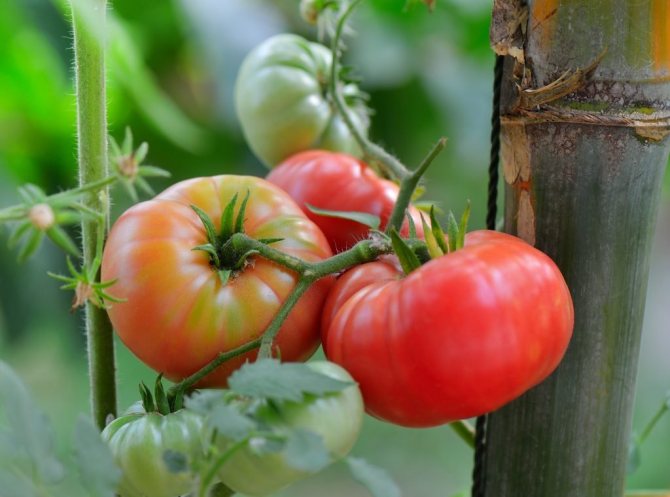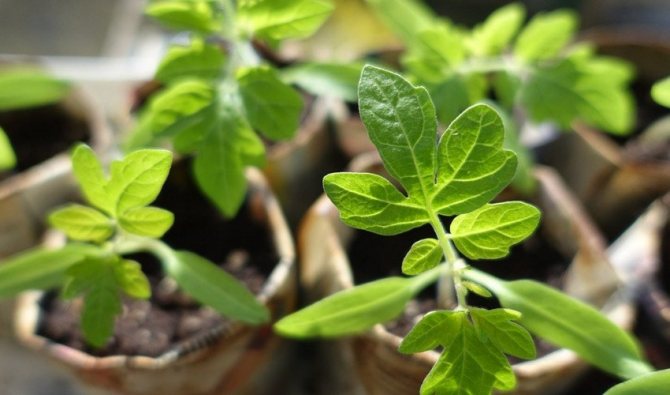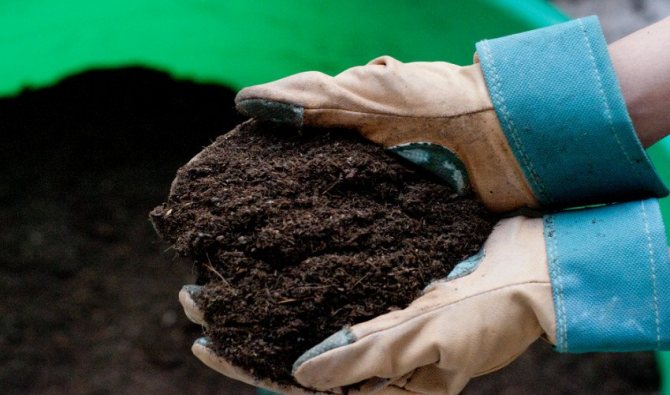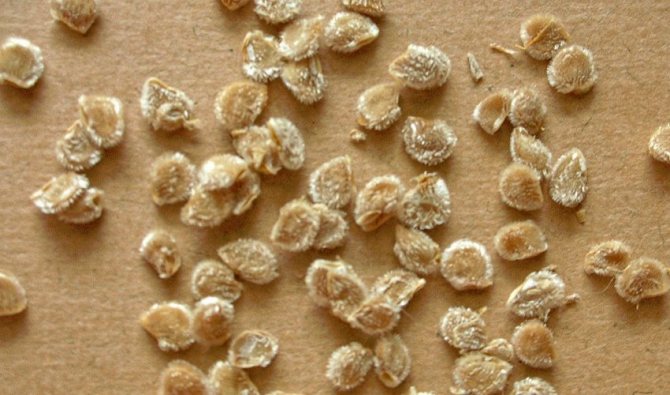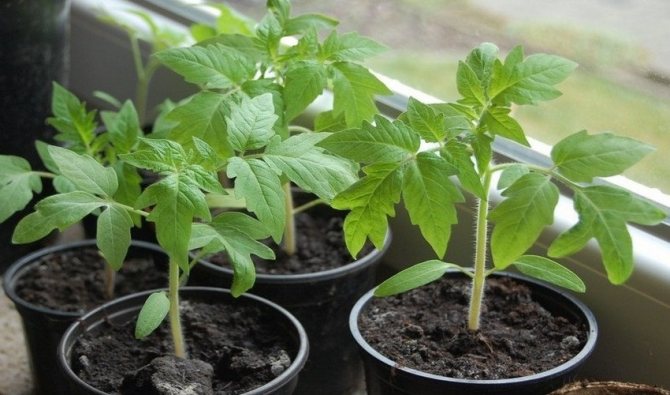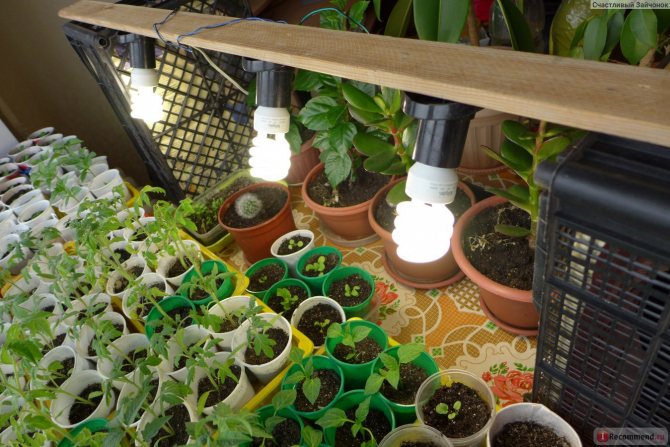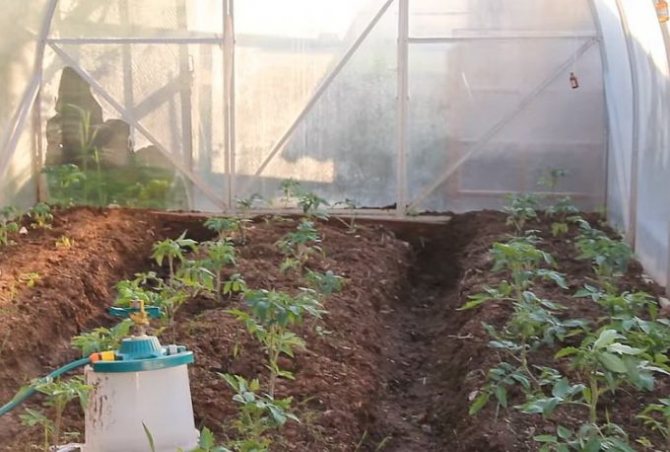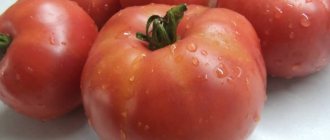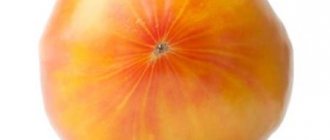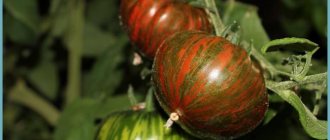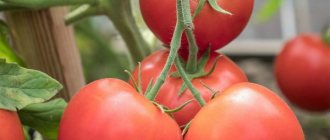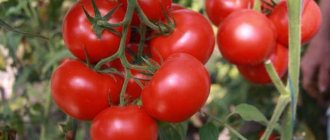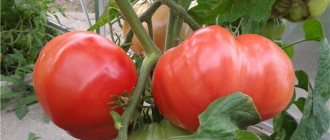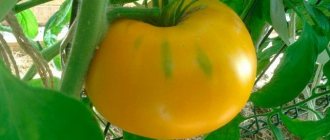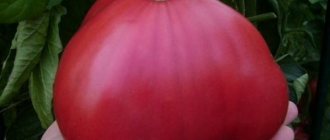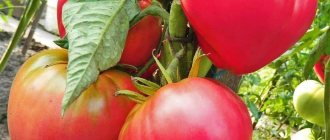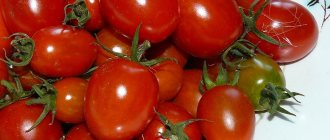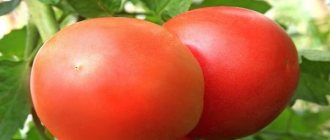Thanks to breeders in love with their work, gardeners have the opportunity to evaluate new varieties of tomatoes. Among the recently developed hybrids, one can pay attention to the tomato with the telling name My love. Its creator is L.A. Myazina. The application for registration of the novelty was submitted in 2007, and in 2008 it was entered into the State Register of Breeding Achievements of the Russian Federation with admission in all regions of Russia. Recommended for growing in open ground and under film shelters in personal subsidiary plots. Can be successfully cultivated in any type of greenhouse. My love is a hybrid, so the seed bag must be F1.
Follow agricultural techniques for a high yield
| Tomato my love | |
| |
| general characteristics | Mid-season |
| Ripening period | 85-90 days after germination |
| Keeping quality (storage safety) | Low |
| Appointment | Salad, canning (for processing into juices and sauces) |
| Fruit weight | 150-200g |
| Number of fruits per cluster | 4-5 |
| Disease resistance | High |
Characteristics and description of the variety:
- Bred by breeder Myazina L. A... Included in the State Register of Plants of the Russian Federation in 2008. This is a hybrid, therefore, there is always an F mark on the package with seeds. It is zoned in all regions of the Russian Federation and is suitable for growing both in open ground and under a film, and in stationary greenhouses.
- Plants of the determinant type, growth is limited to inflorescence. In open ground, plants grow up to 65-80 cm, in a greenhouse they can grow up to 120 cm. Leafiness is weak, leaves are dark green, small, branching is moderate. Up to 5 brushes are formed, each with an average of 5-6 ovaries.
- Fruits are smooth or slightly ribbed, rounded or flat-round. There is usually a small spout at the top, but it may not be present. Unripe fruits are light green in color, turn red as they ripen.
- The variety has an early ripening period, from the moment of emergence to harvest, it takes from 85 to 90 days. Ripening is amicable, literally in two harvests most of the harvest is collected, which is convenient for summer residents who visit the garden 1-2 times a week.
- Excellent taste... The pulp is tender, juicy, sugary, has a pleasant texture and melts in the mouth. The average weight of fruits varies from 150 to 200 grams. Tomatoes do not crack, the flesh looks beautiful when cut.
- Tomato yield under a film cover is about 10 kg per square meter. The author of the variety draws attention to the fact that with proper agricultural technology and good care, up to 5 kg of harvest is removed from one plant.
- Plants tolerate well lack of moisture and temperature extremes. But it should be remembered that any unfavorable conditions will reduce the yield.
- The variety is resistant to most diseases, immunity to the tobacco mosaic virus is particularly high. Due to early ripening, the plants finish bearing fruit before the onset of nighttime cold snaps, therefore they are not affected by late blight.
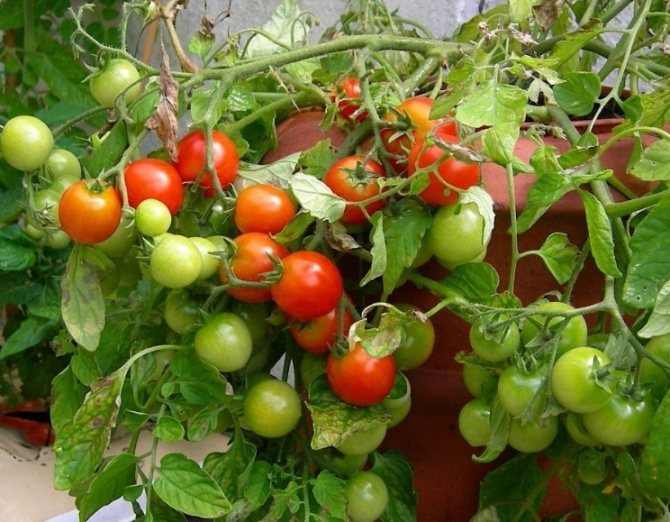

The variety shows the best yield in greenhouses and under film.
Tomatoes I liked last season
Tomato "Sanka"
I will not dwell on this variety for a long time - I have already talked about it. He has been with me for many years and never fails.
According to the description: determinant (grows short, up to 60 cm), does not need any pinching or garter, resistant to jumps in spring temperatures. Does not stretch in seedlings. The first harvest gives quite early and amicably, then bears fruit for a long time. Practically does not get sick. From a bush gives about 3-3.5 kg of tomatoes.
The disadvantages of the variety that I am ready to put up with are not large enough fruits (up to 100 g), not juicy, not very tasty, however, as it should be for all early adopters.
Read more about my experience in growing Sanka tomatoes on our Forum.
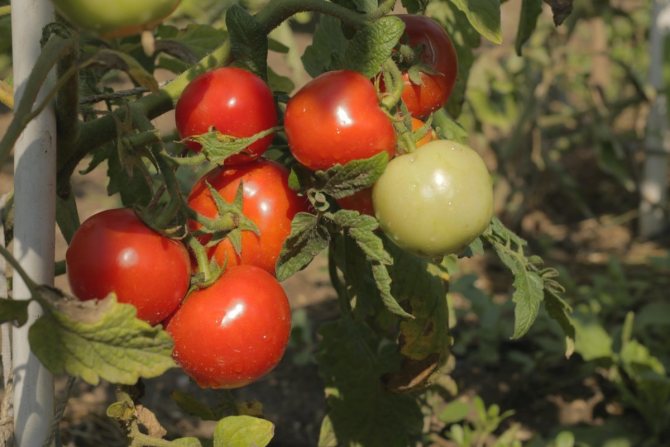

Tomato "Sanka". <оксана>
Tomato "White cherry"
This variety has been with me for many years too. I have it - a delicious "weed". I can't refuse him, and he doesn't let me get rid of him. In the spring it rises everywhere, wherever possible, in a friendly carpet. This year I left him here and there, where there was a place.
Despite the fact that the fruits of "White Cherry" are very small (up to 3 g) and it ripens in the second half of summer - the taste, resistance to diseases and the duration of fruiting are incomparable! Children, guests, and I myself eat the harvest right in the garden - the sweet-spicy taste does not leave anyone indifferent!
"White cherry" grows intensively. The height of the bush is about 60 cm. It can be pinned, then it will ripen a little earlier. You don't need to pinch, then there will be more berries.
Read more about my experience in growing White Cherry tomatoes at the Forum.
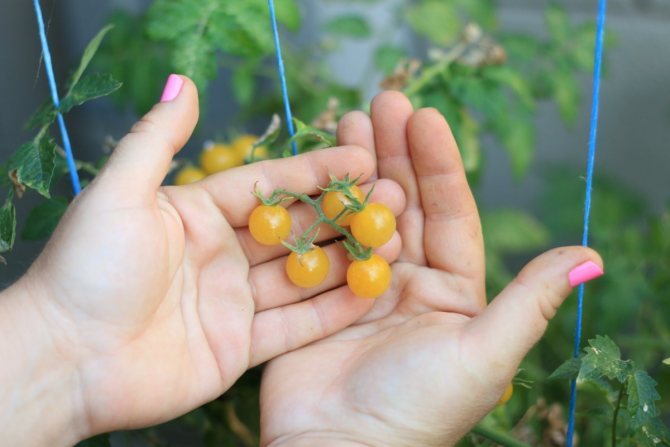

Tomato "White cherry". <оксана>
Tomato "Geranium Kiss"
This variety has been making me happy for two years now. In 2018, I was very pleased with it, last season I decided to repeat it. However, this time she did not grow it through seedlings, but immediately sowed it in open ground. For this reason, it ripened later, but, like last year, it turned out to be quite resistant to diseases and very tasty.
I consider it the most delicious tomato with tomato flavor! And even the most beautiful - the Geranium Kiss brush - is an unimaginably beautiful bouquet (or is it just for those in love with tomatoes ?!)
Early ripe. Determinant. Resistant to major diseases. In height from 50 to 100 cm. In one cluster it knits up to 60 (and more!) Fruits.
More photos of Geranium Kiss tomatoes and my detailed description of the growing process can be found on the Forum.
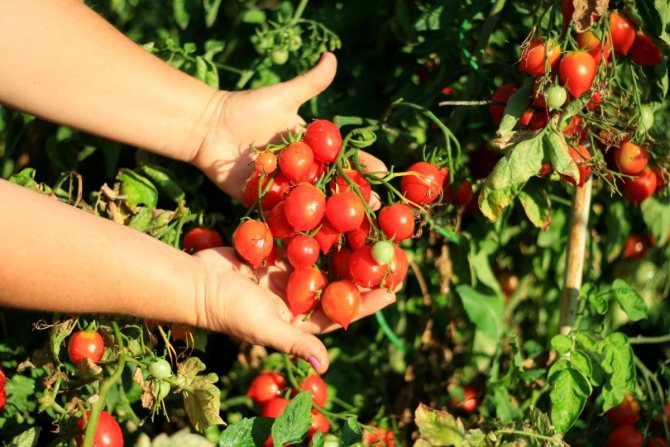

Tomato "Geranium Kiss". <оксана>
Tomato "Ildi"
A new variety for me, but it showed itself from such sides that it definitely goes to the list for planting next year.
Indeterminate. Medium ripening. Cherry. The declared height of the bush is 2 m, mine is 1.4 m. It doesn’t stick too much, you can stick it to the first brush or not at all. The mass of fruits in the description is up to 50 g, I got around 10 g. The brush is complex, forms up to 60 tomatoes, in my case about 40.
I planted two bushes. One in a little shade, the other in the open sun. The one who received more sun ripened earlier, imposed more fruits. Despite the fact that by the end of the season the leaves were covered with spots (the year was very rich in diseases from the beginning of summer), this did not affect fruiting.
The taste of tomatoes is very pleasant: tomato, has some kind of balanced sweetness and sourness. In one cluster, both ovoid and pear-shaped fruits of different color saturation were formed. However, they could be consumed as soon as they turned a little yellow.
Several tomatoes burst, but I can't say that this is a tendency of the variety to crack - rather, due to uneven soil moisture.
For more photos of Ildi tomatoes and my experience of growing it, see the Forum.
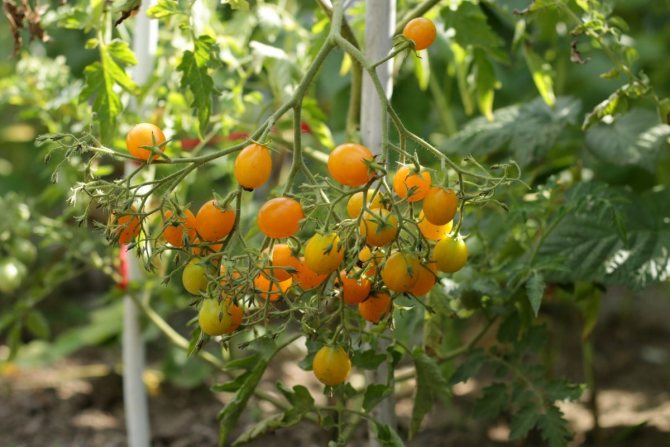

Ildi tomato. <оксана>
Tomato "Bonsai"
"Bonsai" was bought in passing - so the children wanted it. According to the description, it turned out that this is an early maturing, determinant variety, with a yield of 1 kg per bush. Forms a low stem - 50 cm. Fruit weight in the range of 25-30 g. Recommended for window sills.
Despite the heat, I tied full brushes of tiny tomatoes.From the middle of July he began to sing. The weight of the tomatoes in my case turned out to be about 10 g. The taste is pleasant, balanced. It looks cute on the garden bed.
Read more about my experience in growing Bonsai tomatoes at the Forum.
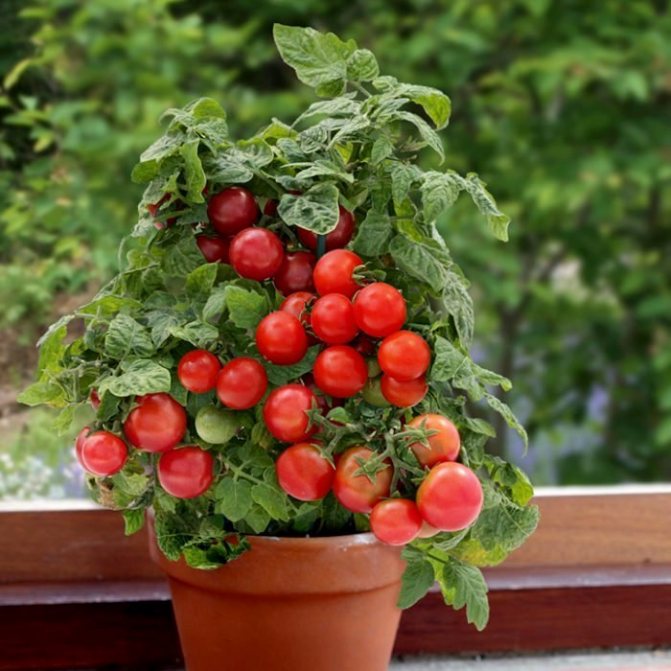

Tomato "Bonsai". <>
How to grow seedlings
Tomatoes are propagated by seedlings that are grown independently.
| Stage 1. Acquisition of high-quality planting material Step 1... Purchase seeds from a reputable store. Avoid street vendors and stalls, most often the quality of the goods there is low. Step 2... Examine the information on the packaging. Check for expired seeds. If the seeds are pre-processed, then this is indicated and the next step can be skipped |
| Stage 2. Protection against infections Step 1... Prepare a 1% solution of potassium permanganate. Stir the liquid well to completely dissolve the crystals. Step 2... Dip the seeds into the solution and keep for no more than 20 minutes, otherwise germination will deteriorate. For convenience, you can wrap the seeds in cheesecloth, then it will be convenient to get them out. Step 3... Rinse the seeds in clean warm water |
| Stage 3. Germination of seeds Step 1... Take gauze, cotton cloth, or other breathable material. Step 2... Place the cheesecloth on a plate, sprinkle the seeds, cover with another layer of material on top and pour over. Step 3... Moisten the fabric every day until sprouting |
| Stage 4. Preparation of soil and containers Step 1... Purchase special containers for seedlings as in the photo or use the containers at hand. Step 2... Use ready-made seedling soil, it does not need to be disinfected. Step 3... Fill containers with soil |
| Stage 5. Growing seedlings Step 1. Sow seeds, cover 1 cm of soil and water. Place in a warm place until germination emerges. Step 2. Provide plants with a normal temperature regime - from 20 to 25 degrees during the day and about 15 degrees at night. |
Description of the fetus
The fruits are small and flavorful. Ripe tomatoes have a beautiful bright red color and a round shape with a characteristic "nose". Ripe tomatoes, on average, weigh 100-120 grams. Vegetables stand out for their versatility and are perfect for both preservation and fresh consumption.
Thanks to their dense skin, they will retain their appearance even when exposed to high temperatures. Tomatoes will also look good fresh. True connoisseurs will appreciate the taste of a representative of this variety.
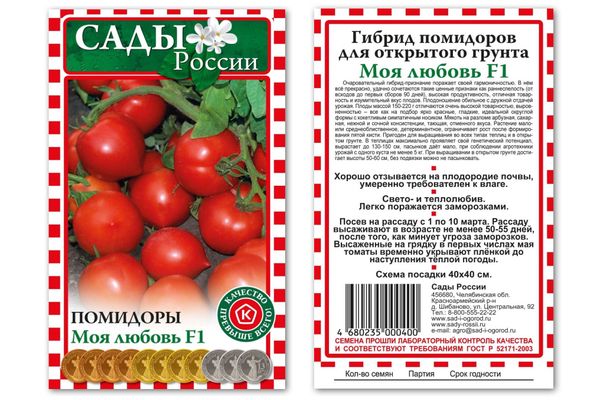

In addition, the fruits have good keeping quality. Tomatoes can be transported long distances. Fruits can be stored in a cool place for a long time. Tomatoes are good for commercial use. Besides the fact that the fruits are beautiful, they are also useful. This variety has a huge amount of vitamins that are useful for maintaining immunity in the body.
Features of the fruit
Large fruits are formed on medium-sized bushes. An average tomato weighs around 250 g. The characteristics and description of the variety from summer residents growing the Lyubov hybrid contain a description of fruits weighing 400 g.
The shape of the fruit is smooth and round. In the state of marketable ripeness, the fruits and pulp are colored bright red. The color is even without the presence of a green spot in the area of the stalk.
The skin is firm, cracking of the fruit is excluded. Tomatoes can be used in many ways:
- making sandwiches;
- preparing salads;
- for dressing summer soups (gazpacho, borsch, kharcho) and second courses;
- in winter preparations (pastas, sauces, ketchups).
How to care for
| Stage 1. Soil preparation and planting Step 1... Apply compost or rotted manure to the area for tomatoes at the rate of a bucket per square meter. Dig up the soil. Step 2... Make holes in a 40x50 pattern. They should be slightly larger than the root of the seedling. Step 3... Plant the plants, tamp the soil around and water well |
| Stage 2. Watering. Step 1... Always monitor the condition of the soil, it should not dry out. Usually tomatoes are watered about once a week, if it is very hot, then the frequency may be higher. Step 2... Water carefully, do not wash out the soil and do not expose the roots. Work is best done in the evening after sunset. |
| Stage 3. Top dressing Step 1... Feed about once every 2 weeks. You can alternate organics and mineral complexes, but you can use only the second option. Step 2... Apply the top dressing 2 weeks after planting the seedlings, then fertilize the tomatoes during flowering so that the fruit sets better. Step 3... During the fruiting period, add a complex composition for tomatoes every 2-3 weeks to provide the plants with everything they need. |
|
Features of agricultural technology
The seeds of the hybrid are sown in early March. They are pretreated with a weak solution of potassium permanganate (1%). The prepared seeds are buried in the ground by 3 cm, moistened, covered with a film. After the appearance of real leaves, the seedlings dive.
The breeder recommends planting hardened seedlings at 50-55 days of growing. Previously, containers with sprouts are watered, the soil is loosened. After planting, fertilizers are applied.
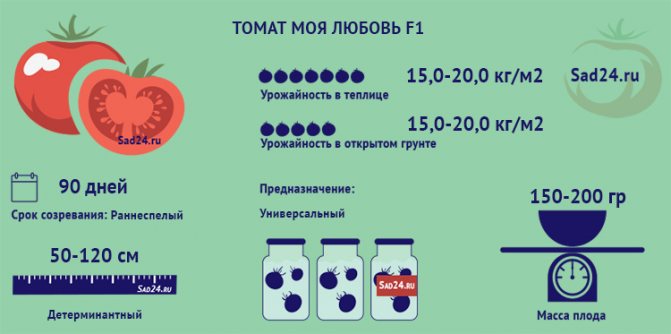

Growing nuances:
- It is necessary to prepare the acidic soil for the tomatoes.
- The variety is picky about fertilizers. Before fruit setting, top dressing is applied three times, alternating organic matter and mineral compositions.
- Needs a well lit place.
- Planting scheme 40 by 40 cm.
- Tomatoes do not tolerate low temperatures well, in case of frost they need shelter.
Attention! For the prevention of diseases, it is important to regularly ventilate the greenhouses, moderately water the plantings. Irrigation of bushes with phytosporin or 1% Bordeaux liquid will prevent late blight.
Advantages and disadvantages
Hybrid My love, bred by breeder Myazina, is successfully grown in summer cottages, in private greenhouses. Numerous photos show the beauty of the vibrant fruit. The variety attracts with its advantages:
- external aesthetics of tomatoes;
- delicious juicy pulp;
- disease resistance;
- the possibility of long-term storage;
- undemanding care (suitable for novice gardeners);
- does not need frequent watering.
Of the shortcomings, gardeners note:
- low yield of tomatoes (about 4 kg from one bush);
- the need for tying;
- weakness of the peduncle;
- require good lighting.
Testimonials
Inna: “For several years in a row I have given priority directly to the tomatoes of the Love variety. And I can't get enough of my own harvest. Up to 6 fruits are obtained from one bush. The taste is rich and sweet. Diseases must be fought with pharmaceuticals or folk recipes. Therefore, I can recommend it as one of the best tomato varieties. "
Elena: “I have been looking for the best varieties of tomato for a long time. The sort of love was recommended by a neighbor. Fruit ripening is surprisingly fast. From a bush, I collect up to 6 kg. For the prevention of various diseases, the bushes, after being transferred to a permanent place, are treated with Fitosporin. If symptoms of the disease occur, the infected bushes must be eliminated by throwing them out of the garden. The fruits are very tasty and have a very long shelf life. Before that, my family preferred mainly Cherry, but these tomatoes replaced them. And it's not so difficult to grow them, water more, tie them up. You can pinch, but the yield will be less. But the tomatoes themselves will be large in size. I recommend it to gardeners and even beginners in growing crops. "
Popular: Six varieties of white cabbage to grow on site
Now read:
- Do-it-yourself correct cultivation of adenium succulent
- Variety of shapes and colors of Calathea from the Marantov family
- Big and tasty harvest with Dutch Romano potatoes
- Foreign, sweet hybrid of ezemalina for a garden plot
About
Chief agronomist of the Limited Liability Company "Association of Peasant (Farming) Farms" Kuznetsovskaya "", Ilovlinsky District of the Volgograd Region.
Diseases and pests
This variety most often suffers from the following problems:
| Top rot Prophylaxis: burning old plants in autumn, ventilating the greenhouse, preventing waterlogging. Fight: all affected fruits are harvested and discarded. Treatment of plants with a solution of nitrate with calcium |
| Bacterial spot Prophylaxis: moderate watering, weeding and loosening of the soil, warming up the seeds before planting. Fight: immediate removal of all affected tomatoes, treatment with Phytoflavin or Hom |
| Colorado beetle Prophylaxis: as such, there are no protection measures, beetles fly long distances. Fight: Inspect and manually collect pests daily. If a clutch of eggs is found on the inside of the sheet, pluck it and discard |
Breeding history of the variety
The variety Moya Lyubov F1 is a hybrid bred by a professional breeder - Candidate of Agricultural Sciences L.A. Myazina. In 2008, it was entered into the State Register of the Russian Federation and recommended for cultivation throughout the country. It can be grown in unprotected ground and in various types of shelters.
Did you know? Red varieties of tomatoes are considered the most useful due to the high content of the carotenoid lycopene, which has a beneficial effect on vision and the cardiovascular system and is the prevention of cancer.
Reviews of gardeners
Igor, Taganrog
He gave seeds to a neighbor, planted them in the OG, with a pinch, a decent harvest turned out. Four brushes turned out, each more than a kilogram.
Rita, Makeevka
Last year there was a crazy heat, and the tomatoes were just burning both the leaves and the fruits. So we bought a mesh, this is a special shading mesh. The seedlings were not hardened, but they did not hurt under the net. On the one hand 5.5 meters by 20, on the other 6.5 meters by 15. I like it.
Basic rules for growing varieties at home
To get an early harvest, the tomato variety My Love F1 is grown in seedlings.
Growing seedlings
For growing tomatoes, you can use purchased soil or make it yourself. To do this, you can mix humus, soddy-leafy soil and peat in a 1: 1: 1 ratio and for disinfection, ignite the mixture in the oven or pour with potassium permanganate. Then, on a bucket of ready-made soil mixture, you must add 1.5 tbsp. ash, 3 tbsp. l. superphosphate, 1 tbsp. l. potassium sulfate and 1 tsp. urea.
The finished mixture is filled into containers for growing tomatoes (boxes, pots, homemade containers). Their depth should be about 10 cm, and the capacity of individual containers should be at least 0.5-1 liters. Before planting, seeds should be processed by placing them in a weak solution of potassium permanganate for 20 minutes, and then rinsing with clean water and drying. If desired, they can still germinate.
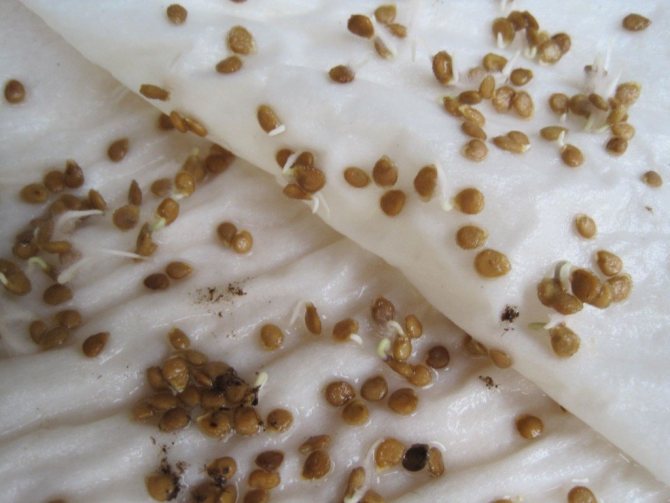

Seeds are planted in boxes according to the 4 × 2 cm scheme, and 1-2 seeds are placed in separate containers. Sowing is carried out to a depth of about 1 cm into a moist substrate. Then the container with the crops is covered with a film and transferred to a dark, warm place (+ 22 ... + 25 ° C), the moisture content of the soil is monitored and aired for a short time every day. After seed germination, the film is removed and the containers are transferred to a well-lit place with a temperature of + 12 ... + 16 ° C for a week.
Outdoor care
Care activities should include:
- timely watering;
- fertilization;
- disease control and pest control.
To preserve the harvest, it is necessary to take timely preventive measures in relation to insects and sources of disease. Also, the set of care measures includes shaping the bush and measures to increase yields.
Watering
Water is required throughout the growing season. Each adult bush consumes about 12 liters of moisture per week. Watering is recommended in the early morning to provide water during a hot day.
But some farmers prefer the evening gravy, since the main growth of plants occurs at night and the moisture at this time will be used for its intended purpose, and not evaporate under the influence of high temperatures.
For a strong root system to develop, water must penetrate deep into the soil. Mulch in the root zone will help retain moisture during the day, protect the lower leaves from splashing during watering.
Place flat stones next to the plants - during watering, they will absorb moisture and gradually humidify the air during a hot day, maintaining an optimal microclimate for tomatoes.


Top dressing
Synthetic or organic fertilizers are applied every 2 weeks, starting from the moment the plants are planted in the ground. When choosing fertilizers, keep in mind that the composition for lawns and flowers is not suitable for tomatoes - it is designed for the growth of leaf mass. Buy only those products that are intended for vegetables.
For the correct calculation of the fertilizer scheme, you need to know exactly the composition of the soil. If you are not sure about the amount of certain substances, start with half the dose of the amount indicated on the package. Also keep in mind that very fast fertilization and accelerated growth make plants more susceptible to disease and insects.
Indicative feeding schedule:
- For seedlings that have been planted in a permanent place, it should take 10 days for rooting. After this, the plants need to be fed. It is advisable to feed with organic fertilizers in the root zone. For example, a mullein solution is applied in 0.5 l for each plant. The solution is prepared from 0.5 kg of mullein, dissolved in 10 liters of water.
- The next feeding is carried out 10 days after the first mineral fertilizers. It can be superphosphate and potassium sulfate in a dosage of 1 tbsp. spoon of the drug in 10 liters of water. Under each tomato, 1 liter of an aqueous solution of fertilizer is applied.
- In the future, you can alternate the types of fertilizers.
Important! Tomatoes contain a number of phytoncides that have an antiseptic effect and block the activity of pyogenic bacteria. Therefore, tomato pulp can be used to heal wounds.
Steying
Pruning of stepchildren (lateral stems) must be carried out so that energy and nutrients are spent on the formation of fruits, and not green mass. Lateral shoots appear in the axils of the main stem. When they are small, they are pinched off, leaving a small column 0.5 cm high.
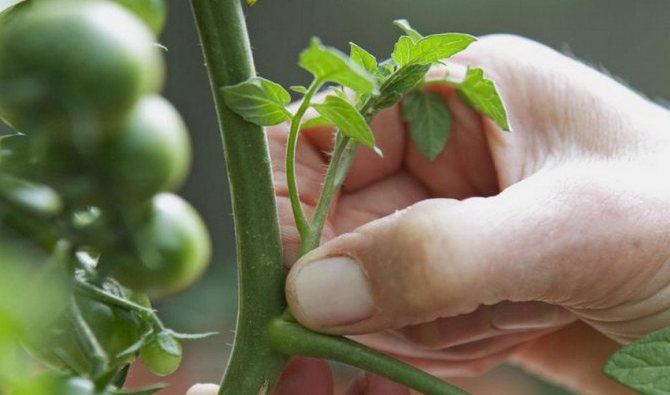

You can also limit the upward growth of the plant by pinching the top of the plant at the height you want. This is a necessary measure, since wild tomatoes are perennials, and nature has not laid natural growth restrictors in them. If the plant grows up all the time, this does not contribute to good fruit formation.
As the stem grows, it is also recommended to remove the lower leaves - they become the source of infection of the plant with rot.
Soil care
Soil management techniques include:
- weeding;
- loosening;
- mulching;
- hilling.
Tomatoes thrive on loose soil. Therefore, after each abundant watering, it is loosened and weeds are weeded. Loosening is carried out to a depth of 8 cm on the 2nd day after watering.
Hilling is not considered a mandatory agricultural technique for tomatoes, but some sources recommend this method as improving the development of the root system. Strong roots form a sturdier bush, which has a positive effect on yield.
Therefore, it is recommended to spud tomatoes 2 times during the growing season: 3 weeks after rooting and during the period of active flowering.
Mulching consists in placing organic components in the root zone of the plant - straw, grass, sawdust.Mulch makes it easier to care for plants, since with it there is no need for weeding or additional loosening of the soil.
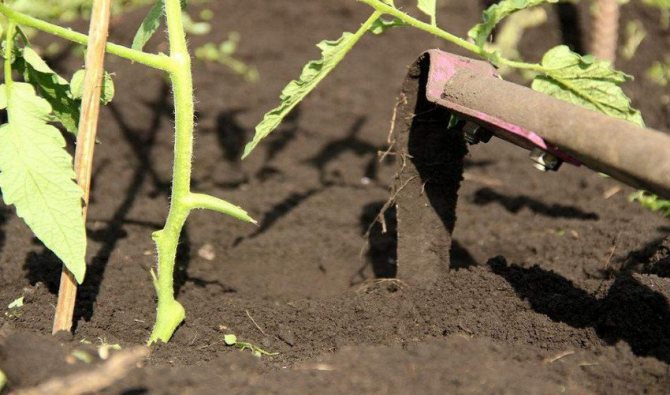

Mulch also protects the root system from excessive moisture loss and contact with pests, which also has a positive effect on yields. You can use both organic and inorganic mulch for tomatoes - agrofibre, spunbond, etc. The mulch is laid so that there is little space for watering near the trunk itself.
Tying a bush
To help the bushes hold the ripening mass of fruit, the plants must be tied up. Caring for such plants is much easier: it is more convenient to spray them, remove stepchildren, and harvest.
You can tie undersized varieties to pegs, and tall ones, like "Love F1", are tied to a trellis. To do this, supports are installed at different ends of the row, a wire is pulled over them, to which the bushes are attached.
Plants can be tied up 2-3 times at different heights:
- 0.4-0.5 m;
- 0.7-0.8 m;
- 1.2-1.3 m.
Pieces of tissue are used for tying because of their low injury hazard to the trunk. You can also find special tying clips in the store. They are made of soft plastic and can be used for both horizontal and vertical mounting.
And so that the clips can be used next year, be sure to disinfect them at the end of the season before storing them.
Important! Young plants need support in the same way that humans need a spine to stay upright. The trellis supports the vertical direction of stem growth, promotes free air movement and is a means of preventing putrefactive processes.
Preventive treatment
To achieve maximum yields, plants need to receive sufficient nutrition, are not exposed to diseases and are not weakened by pests.
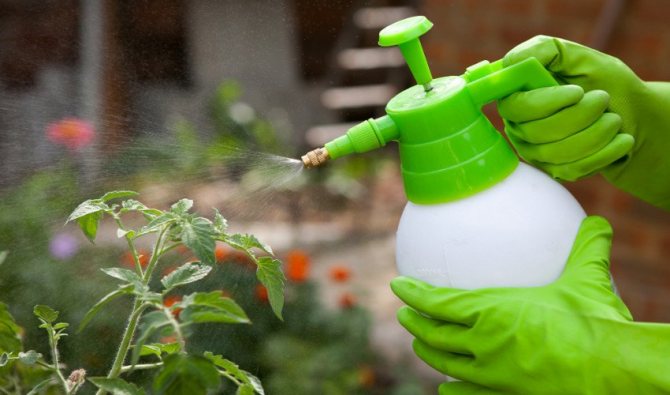

For this, the following measures are observed:
- after harvesting, organic residues are destroyed away from the garden;
- if in the process of growing the plant was affected by pests, then it is necessary to observe the correct crop rotation and not plant plants in the same area;
- before planting new plants, the soil should be decontaminated from pests and diseases;
- before planting seeds, growth is stimulated;
- also take into account the general condition of the soil: acidity, nitrogen, potassium and phosphorus content.
In addition, when buying seeds, consider which diseases are resistant or not resistant to the variety, and correlate this with the actual state of your beds.
It will also be useful for you to find out why and how to properly process tomatoes with boric acid, Bordeaux mixture, brilliant green, whey with iodine.
Variety care after transplanting
This variety can be successfully grown even by novice gardeners, since it is not too picky about care. In the open field, it does not need to be pinned, that is, to remove excess leaves and shoots. If this is done, then the tomato will bear fruit much later.
This hybrid has practically no extra stems, except for the first two shoots. If you remove them, then the fruits will be larger, but the overall yield of the bush will decrease.
During the entire growing season, tomato love responds well to potash and phosphorus fertilizers. A feature of the variety can be called tolerance to a minimum amount of moisture, as well as good tolerance to different temperatures and lack of lighting.
A big plus is that the hybrid is actively bearing fruit before the onset of frost.
Formation of determinant tomatoes on video
If you have grown tomatoes Love f1, please write whether you like them or not. Will you grow them again? How do you rate the resistance of this hybrid to diseases? Briefly describe the advantages and disadvantages of this tomato. If possible, attach a photo of the entire bush or individual fruits that you have grown to your review. Thank you!
Your reviews about the tomato Love and additions to the description will help many gardeners evaluate this hybrid more objectively and decide whether to plant it or not.
Buy tomato seeds Cornabel
Russia Gardens
Hit of the season 2020! A novelty that has shown a stunning result! High yield! Great fruit taste!
The opinion of summer residents about the tomato "Love f1"
Tomatoes of the Lyubov variety are tasty, juicy and outwardly very attractive tomatoes, which are excellent for eating both fresh and for preparing preparations for the winter.
Timely, proper plant care, regular feeding and hydration, pest control will allow even an inexperienced gardener to grow good seedlings and get a high yield of excellent quality fruits.
- Olga: The neighbor really liked this hybrid, so I planted it in the spring. Indeed, the plant is very prolific. Care for him is mediocre, as for all determinants. Personally, I form in 3 trunks to make better use of the greenhouse.
- Irina: For the second year I have been planting a tomato Lyubov. Everything that is written on the seed package is true. One caveat: the fruits ripened near the roots are sweeter and more juicy than the top ones. I planted it at the wrong time that year, picked brown tomatoes that were ripe but not so tasty.
- Inga, Chelyabinsk: For the second season I opt for this hybrid. His description on the bag is fully consistent with reality. The only thing I want to note on my own is that the taste of ripened tomatoes is more harmonious and sweet.
Last year, I did not guess the timing of planting, I picked brown tomatoes, which were ripening, but inferior in taste to the current ones, ripened right on the bushes. - Elena, Moscow region: Love planted this spring, because many friends are delighted with this hybrid. Productivity pleased - a prolific hybrid. I looked after in a standard way, as I take care of all "children", I form not 2 trunks, but in 3 - for a more complete use of the greenhouse space.
- Elena, Saransk: Love F1 planted for the first time. I grew tomatoes in a greenhouse, a lot has grown, the yield has pleased. I liked the round, tasty tomatoes.
- Victor, Lipetsk: I planted a tomato of the Lyubov variety on my personal plot. He grew a hybrid in greenhouse conditions. I was struck by the fact that in a minimum of time spent, I got a good harvest. I will definitely plant more seeds next season.
- Stepan, Khabarovsk: Last season, I planted tomatoes in my dacha Lyubov: nothing surprising. The harvest was not happy, apparently, I did not properly care for the vegetable bushes. I prefer to choose other varieties for yield.
- Galina, Moscow: The taste of tomatoes did not impress, the most ordinary one - no better than that of store-bought tomatoes. Tomatoes began to ripen quite late, and not as the description states. I will not grow this hybrid anymore.
- Alexandra: For the first time I planted the variety "Love". It grew in a greenhouse, there were a lot of bushes, they were pleased with the harvest. The tomatoes are round, delicious.
agronomu.co
How I choose tomato varieties
Growing up, I realized that the crop yield depends on many factors. And most likely one of the significant reasons for the poor harvest of tomatoes from my grandmother (in the middle lane) was the variety.
Every year, all over the village, girlfriends and neighbors exchanged seeds and planted several varieties with the same fruits - cream and one round, I can't even remember the names. The dismal picture of the meager tomato beds did not differ where the grooming was better, nor where the tomatoes were hardly followed. Now I understand that this was a natural degeneration of the varieties.
At my mother (in southern conditions), the need for constant pinching and daily watering repelled me from tomatoes. In addition, at high temperatures, tomatoes ceased to set fruit and were more tired than pleasing. In general, for the first time planting tomatoes with seedlings from the market and analyzing the result, I decided that if I plant, then something unusual.
Accidentally hitting one tomato collector, I made my first order and was right. No, some of the varieties were never planted again, but some gave a crop, even though during the construction period (and we had just started construction then) there was no time to pinch and water the tomatoes every day. Then I realized that the variety is the main thing for the yield of tomatoes, and everything else is secondary.
The next technique I learned to use is testimonials. If during the year I see that someone praises a variety, I mark it in my notebook and look for other reviews. Usually, you can learn much more from the descriptions of gardeners than from advertising descriptions: how tasty the variety is, how susceptible to diseases, to changes in spring temperatures, to high summer temperatures, whether it is prone to cracking, to the formation of top rot, green shoulders. Agree - this is important, and no one, except those who have already grown this tomato, will tell you about it.
Next, after analyzing the list, I choose a certain number of varieties that can fit in my beds. One of them is necessarily early, trouble-free, long-term fruiting. Such varieties are not tasty, but they ripen earlier than others and become a guarantee that you will not be left without a crop. Several averages. And a few later ones.
Harvesting and storage rules
The fruits of the tomato variety Moya Lyubov F1 ripen together and the bulk of the crop can be harvested in just 2 times. Tomato specimens that did not have time to ripen before frost can be plucked brown-green and ripened.
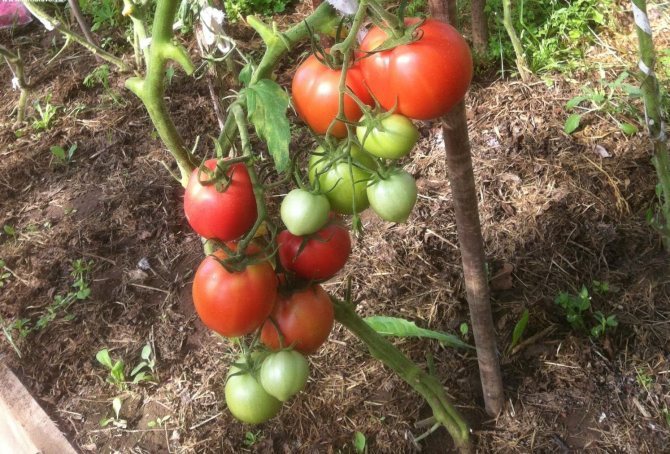

Tomatoes are stored in the basement in boxes, wrapped in paper and turned upside down or covered with sawdust. The number of tomato layers should not be more than three. If there is no cellar, then you should use the refrigerator. In the refrigerator compartment, it is best to store tomatoes wrapped in paper and never put them in a plastic bag. Periodically, vegetables are sorted out in storage.
Did you know? To make tomatoes of milk ripeness or brownish fruits ripen faster and turn red, they are placed in a paper bag with an apple. The ethylene gas emitted by this fruit accelerates the ripening of tomatoes.
Hybrid tomato varieties My Love F1 can be grown in any region of the country, while they have the ability to ripen early and bring a good harvest with proper cultivation techniques.
Characteristics
- Hybrid My love ripens in the early stages - from the moment of the emergence of friendly shoots to the beginning of ripening, 85 - 90 days pass;
- According to the State Register of Breeding Achievements of the Russian Federation, the yield of marketable fruits under a film cover reaches 10 kg per 1 square meter. The author draws attention to the fact that with proper agricultural technology, 5 kg of fruits can be removed from one plant;
- ripening is amicable, which means that for 2 harvests you can remove the maximum number of tomatoes;
- tomatoes do not crack;
- the immunity of the variety is high, especially against the tobacco mosaic virus. Due to the early and amicable ripening of the crop, the plant leaves phytophthora during possible early night cold snaps;
- My love is drought tolerant, tolerates temperature changes well;
- the way of eating fruits is universal. They are used in the preparation of salads, processed into juice, canned.
Planting dates for seedlings
The main guarantee of growing tomatoes is the correct planting of seeds. The optimal time for sowing seeds is the third decade of March, the first days of April. The seeds are planted in the soil at a depth of 3-4 cm.
After 3-4 leaves grow on a tomato bush, it is necessary to transplant into a large, capacious container. Sowing seed for seedlings is carried out approximately 60 days before the intended planting.
The optimal fit is 70 cm by 40 cm.The tomato variety is easy to grow and get a good harvest, you just need to properly care for the fruits and follow all the suggested recommendations.
Requirements for soil for planting and sowing rules for tomato
Tomato love grows best in slightly acidic soil, rich in nitrogen, potassium, phosphorus and calcium. If the acidity index is less than 6.0-6.8, then lime must be added to the soil. If it is higher, then it is necessary to scatter sulfate granules over its surface.
Tomatoes respond well to the introduction of compost and rotted manure, which not only improve the composition of the soil, but also provide the plant with all the necessary nutrients. To do this, it is enough to add compost or manure during planting, and then feed it 2-3 times during the growing season.
The best predecessors for tomato are:
- zucchini;
- cucumbers;
- carrot;
- dill;
- parsley;
- cauliflower.
But in order to get a good harvest of tomatoes, it is necessary to grow seedlings. The best time for sowing seeds will be the third decade of March - early April. The sowing depth of seeds is 3-4 cm. After the appearance of 3-4 leaves, the tomato love can be transplanted into a larger container.
Before planting seedlings in the ground, you need to harden them, for which you need to take them outside in the daytime. Tomato seedlings, which should be strong and healthy, can be planted in the ground 2 months after sowing the seeds.
To get a good harvest, the distance between bushes of this variety in a row should be at least 45 cm, and between rows - at least 75 cm, so that there are no more than 4 plants per 1 m². After planting, all the tomato stems love must be gathered together and tied to a support.
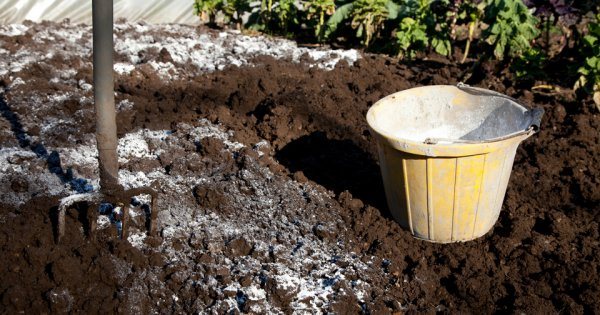

Adding lime to the soil before planting seedlings
Description and characteristics of the variety
Tomato Eternal Love is an indeterminate tall variety. The height of the shoots ranges from 1.5 to 1.8 m.
The tomato is intended for the greenhouse, has an average ripening period of 100-110 days from germination.
Large, fleshy fruits are highly prized. The average weight ranges from 300 to 500 g. Large specimens grow up to 800 g.
Excellent taste harmoniously combines well-expressed sweetness with light sourness.
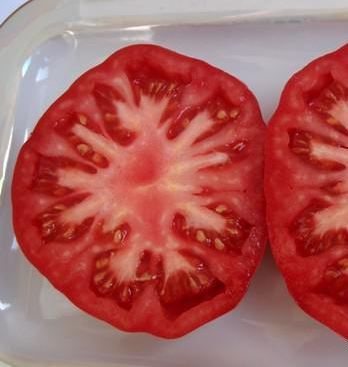

Acceptable timing for growing
Early tomato hybrids are planted in a permanent place in protected or unprotected soil at the age of 50–55 days. On average, it will take about a week for tomato seeds to germinate. Seedlings are planted when the soil warms up to + 12 ° C. The threat of frost must pass and the air temperature must be at least + 15 ° С.
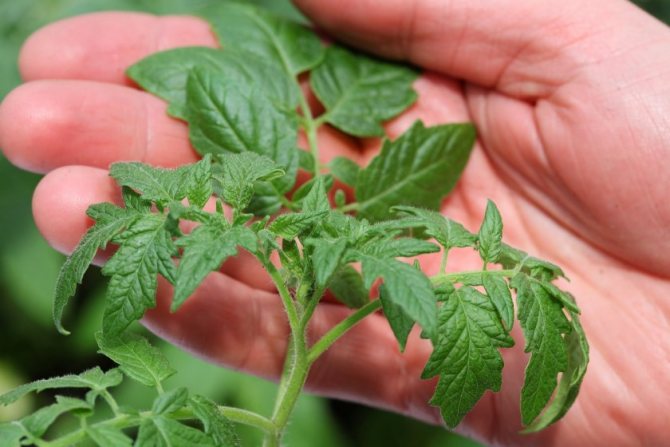

In the middle zone of the Russian Federation, such weather is usually observed in the first decade of June. In shelters, you can land several weeks earlier. In the southern regions, early or medium-ripening tomato seeds can be sown in the ground from the end of April.
Features of the hybrid
Any gardener who follows agricultural techniques can achieve a yield of 20 kg. from the square. This is a high score for the determinant.
The height of greenhouse bushes reaches 1.3 m, in the beds they are slightly lower. Plants produce many leaves of medium size and classic green color.
The first brush has a simple structure and is formed in the bosom of 7 or 9 leaves. You need to leave the stepson under it so that the bush takes on the correct shape. A second stem will form from it, and all stepchildren that form in other leaf sinuses must be cut off in time. But this should not be done immediately, but when they grow up to 5-7 cm. Only small hemp 0.5 cm in size should be left. Another shoot does not grow in this area, which saves further time costs.
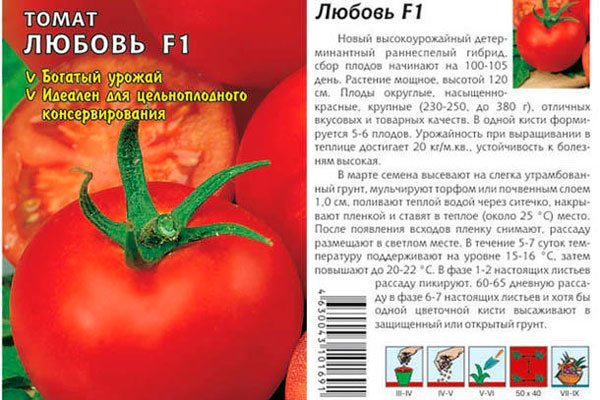

Description of tomato
Tomato love f1 has bushes up to 1.3 meters. Ninety days pass from planting to the appearance of ripe fruits. It is a mixed species for cultivation, on open ground, as well as in a greenhouse. Differs in high resistance to cracking. The plant is resistant to diseases and insect attacks.
With excellent care, no more than 6 kg can be harvested from one bush. Thanks to the correct planting, a yield of 20 kg per m2 can be achieved.
A ripe tomato of scarlet or dark raspberry tone, rounded shape, differs in a flat surface, without folds, a green spot near the stalk. The pulp of tomatoes is quite sugary, but with sourness. One brush includes 5 or 6 large-scale tomatoes. Tomato weight up to 230 grams. The fruits are the same. The pluses of the variety include:
- frost resistance;
- high productivity;
- great taste;
- resistance to low light;
- drought and heat tolerance;
- perfectly tied regardless of atmospheric conditions;
- resistance to stress.
Among the disadvantages are fixed:
- obligatory sturdy support;
- the need for constant feeding;
- frequent curliness and shedding of leaves.
Planting and care rules
If desired and depending on the growing conditions, it is possible to prefer sowing seeds in open ground or the seedling method. They have no advantages over each other, with the exception of the approach of the timing of the first harvest.
Growing seedlings
Tomato variety Love F1 is sensitive to soil nutrient content. In the fall, rotted manure is necessarily brought into the beds, and for seedlings they acquire universal soil. If further transplantation to the beds is planned, then the end of March is chosen for sowing. If a transplant into a greenhouse is required, then they sow earlier - in the first decade of March.
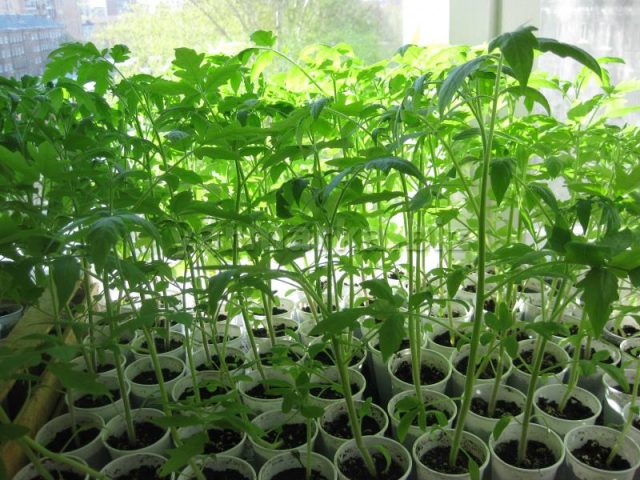

Tomato seeds of the variety Love F1 are sealed to a depth of 2 cm in a common container. Seedlings appear at temperatures from + 18 ° С for 4-5 days. In order not to moisten the soil every day, it is covered with cling film or glass, thereby creating a slight greenhouse effect. As soon as 2 true leaves appear on the plants, you can dive into individual cups. After a couple of days, you can feed the variety.
Advice! The preparation Agricola is ideal for this purpose.
Before planting in a greenhouse or on a garden bed, watering tomatoes is carried out as the soil dries in cups. Hardening is the recommended procedure, which begins a week before the expected transplant date. Seedlings of this variety are taken outside in the afternoon for 2 hours, leaving in a shaded place.
Transplanting seedlings
An adult is considered to be a tomato seedling of the Love F1 variety at the age of 60 days. By this time, with sufficient nutrition, the first buds may already appear on the bushes. The quality is evidenced by the dark color of the foliage, the short distances between the sinuses. With sufficient lighting, this is exactly how the tomato seedlings grow Lyubov F1. If the lighting is too poor, then the plants stretch out, become pale. It will be harder for them to take root in the fresh air.
The crown of a tomato of the Love F1 variety is not pinched, controlling only the absence of stepchildren. Only 1 stepson is left, since the plant does not have enough strength for a larger number of branches. This technique is especially recommended for greenhouses, and in the garden you can do without stepchildren at all, which will have a positive effect on the size of the crop.
When transplanting to a new place, they immediately take care of the supports. Trellises are ideal, as well as wire stretched over the posts at the ends of the beds. In greenhouses, vertical twine tying to stationary slats is practiced.
The recommended scheme for planting a tomato variety Love F1 - in a checkerboard pattern, leaving 70 cm between rows and 40 cm between individual plants in a row. The direction of the beds, which are usually formed from 2 rows, is from east to west for the best illumination.
Follow-up care
Tomato variety Love F1 is sensitive to soil acidity. The optimum pH level is 6.0-6.8. If the indicator is lower, then a small amount of lime is added to the soil. Of the mineral dressings, those that contain potassium, nitrogen, calcium, phosphorus are best suited.The first time fertilization is applied 2 weeks after transplanting, giving the plants time to adapt.
You can not buy top dressing by using wood ash. It is diluted in the proportion: 1 glass to 10 liters of water. An alternative is potassium sulfate. This fertilizer is difficult to dissolve in water. It is usually brought in when digging up the beds in spring or autumn. With each watering, the substance in small doses will go to the roots of tomatoes Love F1.
The beds must be kept clean by regularly removing weeds. If possible, a layer of sawdust and straw mulch is poured under the bushes. This helps prevent the soil from drying out too quickly and prevents weeds from overgrowing. Usually 2 waterings per week are sufficient. The water should be warmed up to + 20 ° С, settled. It is a mistake to believe that a lot of watering is only good. If the ground part is ahead of the root in growth, then there will be no large ovaries on such a plant.
How to grow
Consider the features of growing tomato My love.
Soil requirements
Prepare the soil for planting by digging and loosening it. If the soil is compacted, a little sand or peat is added to it. Acidic soil is mixed with dolomite flour or chalk, or lime is added to it (once every 3 years).
Reference! Sprinkle the seedlings with fluffy soil rich in oxygen. Prepare it in advance, before landing.
Sowing rules


Seeds are planted from mid-March to early April. The land is prepared and fertilized in advance.
The largest and strongest specimens are selected from the packaging. To increase germination, they are soaked in a growth stimulator. Some vegetable growers wash the grains with a solution of potassium permanganate to prevent fungal diseases and destroy traces of pests. However, the planting material of the hybrids has already passed the necessary processing at the manufacturer.
When the seeds hatch and the first 2 leaves appear, the plants dive into separate containers. The strongest seedlings are chosen. After 2 months (late May-early June), the seedlings are planted in open ground. Before that, they are tempered in the fresh air for better adaptation to new conditions.
When growing tomatoes in a greenhouse, sowing is carried out already at the beginning of March. Such seedlings will yield a good harvest by the end of June.
The planting holes are dug 40 cm apart, the distance between the rows is 70 cm. There should not be more than 3 plants per 1 m2. Fertilizers are placed in the pits with the elements necessary for the culture: potassium, nitrogen, phosphorus. The holes are made at least 20 cm deep: they should be larger than the rhizome, which will ensure a high-quality pick of the plants.
Post-transplant care
To grow a good harvest, the crop is properly cared for throughout the summer:
- watered at least once every 5 days;
- tie bushes to a support;
- weed the beds, remove weeds and loosen the soil between the rows;
- prevent plant diseases;
- remove stepchildren;
- feeding tomatoes.
Despite the fact that the hybrid tolerates temperature changes and drought well, in the first weeks after planting in open ground, it needs to be covered with a film.
Grassing the bushes in the greenhouse ensures the early ripening of the fruits. Outdoors, plants have a sturdier stem, so it is not necessary to tie it up and support the branches. In soil tomatoes, garters and supports can significantly slow down and prolong the ripening process.
When cultivating a hybrid in central Russia in the open field, the seedlings are covered with a film during the first month after planting. After it is removed. In the northern regions, crops are grown only in greenhouse conditions.
Tomato My Love is quite unpretentious in watering, tolerates drought with restraint. Warm water is used for irrigation. Watered once every 5 days, in the evening. One day after the soil is moistened, it is loosened and weeded.
Phosphorus and potassium supplements are very important for fruit ripening. Fertilize bushes with them at every stage of growth.In the future, they switch to complex formulations. Mulching the soil increases yields and reduces the frequency of loosening the beds.
Clusters with tomatoes, as a rule, are formed on 7-9 leaf axils. To get the desired shape of the fruit, the stepson is left under these brushes: a second stem will form from it. Subsequent stepchildren, growing up to 6–8 cm, are cut off in time.
Attention! When removing the stepson, a small "stump" of 0.5 cm is left to avoid the emergence of a new shoot in this place.
Saving tomatoes from diseases
The variety is rarely exposed to diseases such as fusarium, late blight, alternaria. Problems can arise due to violation of the rules of cultivation. It is necessary to monitor the humidity regime and avoid overflows. In a greenhouse, it is recommended to take care of the illumination of the plants and a regular supply of fresh air.
Sometimes growers are faced with bacterial spotting. The contact fungicide Fitolavin effectively copes with the disease.
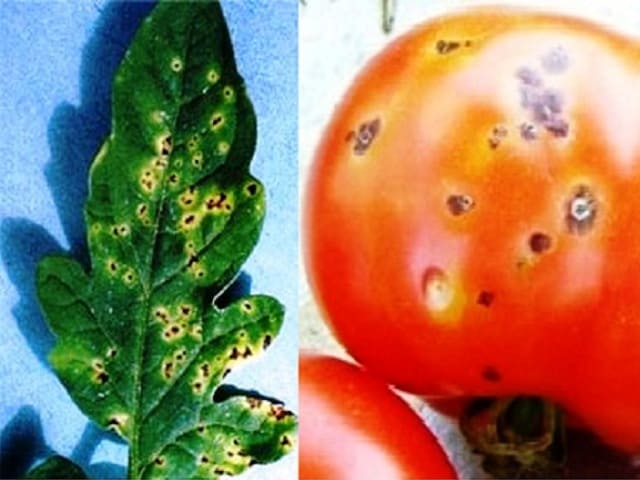

When top rot is found, they resort to processing with a mixture of nitrate and calcium. The appearance of such a problem signals an increased soil moisture.
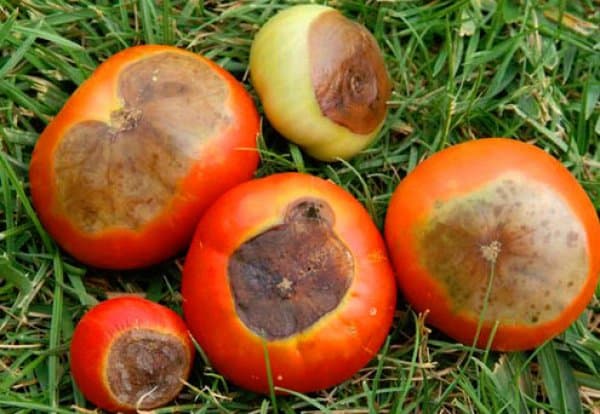

Often the Colorado potato beetle annoys gardeners. It is recommended to get rid of pests with the help of preparations presented on the shelves of specialized stores.
Let's summarize
- hybrid variety that does not require complex care;
- refers to the determinant type;
- large fruits have good taste, tolerate storage and transportation well, are universal in use;
- has a high and long-term yield;
- early ripening variety;
- resistant to common diseases. Needs protection against bacterial spotting, apical rot and Colorado potato beetle;
- it shows itself well, both under films and in open soil;
- does not respond to lack of watering, light;
- copes well with temperature jumps;
- bushes do not need pinching;
- tomato Lyubov gratefully responds to feeding.
Growing recommendations
Sowing dates must be determined taking into account the planting site and the climate in the area where your site is located. Cultivation begins with the preparation of seeds for sowing. Homemade seeds are advised to be sorted and disinfected. It is necessary to sow them with embedment to a depth of 2 cm.Then the container with seeds must be covered with a film and taken to a place where the temperature is 25 C. Incandescent lamps are prohibited.
Popular: Decoration and hot pepper dish on the windowsill
In phase 2 of these leaves, it is recommended to plant seedlings in cassettes or glasses. The need for seedlings for feeding depends on the soil and partly on the temperature in the greenhouse. Extracts from humus, Fertik are suitable for fertilizers. Quenching at 14 ° C is recommended before planting.
Before planting, it is advised to apply, in terms of 1 m2, a bucket of compost, a glass of ash and 25 grams of superphosphate. Up to 5 plants are planted per meter.
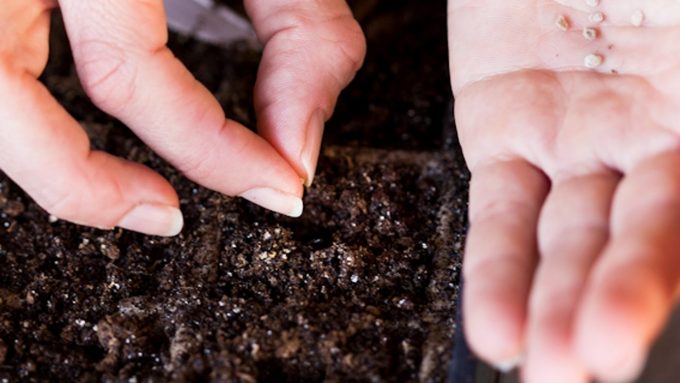

Pros and cons of a hybrid
The virtues of culture:
- the skin of the fruit is dense, due to which they do not crack, can be stored for a long time and transported far;
- a high level of productivity among determinant bushes and fruiting until the very cold;
- resistance to major diseases of culture;
- the possibility of growing in open ground (in the southern regions without film);
- plants can do without regular watering, do not respond to low light and sudden temperature changes;
- ripe fruits have excellent taste (there is juiciness, sourness, sugar content, aroma);
- simultaneous ripening of vegetables.
The disadvantages are:
- dependence of crop volume on fertilizers: root and foliar feeding significantly affect productivity;
- a pronounced fresh sourness in the taste may not appeal to lovers of sweet tomatoes;
- the need for a garter of plants;
- dense foliage, which makes it difficult to collect fruits and care for bushes.
How is sowing done?
Before planting seeds, they must be treated with a weak solution of manganese. This is to ensure that the seeds are not damaged by fungi or pests. Seeds are planted in mid-March or early April in prepared fertilized soil. After the plant hatches and the first leaves appear, they must be dived.
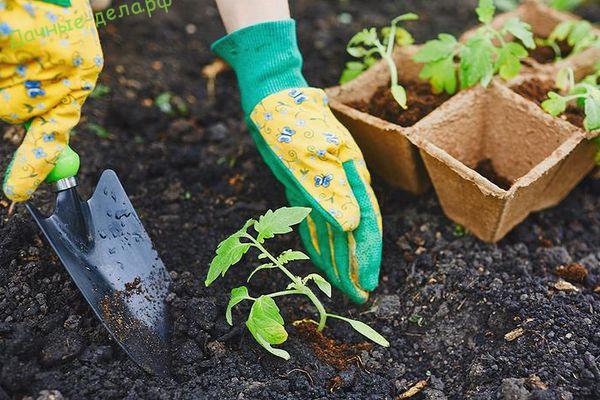

You can plant a plant in open ground in two months. Before planting a seedling in the ground, it is necessary to prepare the plant for the environment by hardening. Plant care consists of regular watering, loosening the soil, and fertilization. The variety is early maturing, the first fruits can be obtained in 80 days.

